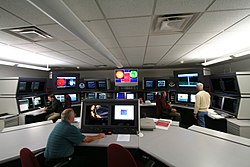

|
No edit summary
|
No edit summary
|
||
| Line 1: | Line 1: | ||
[[File:Inside Space Weather Prediction Center in Boulder.jpg|thumb|250px|Forecasters inside the Space Weather Forecast Office of NOAA's Space Weather Prediction Center (SWPC) in Boulder, Colorado]] |
[[File:Inside Space Weather Prediction Center in Boulder.jpg|thumb|250px|Forecasters inside the Space Weather Forecast Office of NOAA's Space Weather Prediction Center (SWPC) in Boulder, Colorado]] |
||
[[File:Space Environment Center logo.gif|right]] |
[[File:Space Environment Center logo.gif|right]] |
||
The '''Space Weather Prediction Center''' ('''SWPC'''), |
The '''Space Weather Prediction Center''' ('''SWPC'''), titled the Space Environment Center (SEC) until 2007<ref>{{cite web|title=2009 Community Review of the NCEP Space Weather Prediction Center|url=http://www.ncep.noaa.gov/director/ucar_reports/SWPC_Report_UCAR_Final.pdf|accessdate=12 January 2017|pages=7-8|format=PDF document|date=December 2009}}</ref>, is a laboratory and service center of the US [[National Weather Service]] (part of the [[National Oceanic and Atmospheric Administration]] (NOAA)) located in [[Boulder, Colorado]].<ref name=vastag2012wp/> SWPC continually monitors and forecasts Earth's [[space environment]], providing [[Sun|solar]]-[[Earth|terrestrial]] information. SWPC is the official source of [[space weather]] alerts and warnings for the [[United States]]. |
||
==Description== |
==Description== |
||


The Space Weather Prediction Center (SWPC), titled the Space Environment Center (SEC) until 2007[1], is a laboratory and service center of the US National Weather Service (part of the National Oceanic and Atmospheric Administration (NOAA)) located in Boulder, Colorado.[2] SWPC continually monitors and forecasts Earth's space environment, providing solar-terrestrial information. SWPC is the official source of space weather alerts and warnings for the United States.
The Space Weather Prediction Center is one of the nine National Centers for Environmental Prediction (NCEP) and provides real-time monitoring and forecasting of solar and geophysical events, conducts research in solar-terrestrial physics, and develops techniques for forecasting solar and geophysical disturbances. The SWPC Forecast Center is jointly operated by NOAA and the U.S. Air Force and is the national and world warning center for disturbances that can affect people and equipment working in the space environment. SWPC works with many national and international partners who contribute data and observations.
A few of the agencies and industry that rely on SWPC services:
The Federal Aviation Administration requires dispatchers to take into consideration HF communication degradation for each dispatched polar flight. Flights can be diverted based on SWPC solar radiation alerts if air traffic control communication is compromised, with estimated costs as high as $100K per flight. A 23-day period in 2001 saw 25 flights diverted due to such radio blackouts.